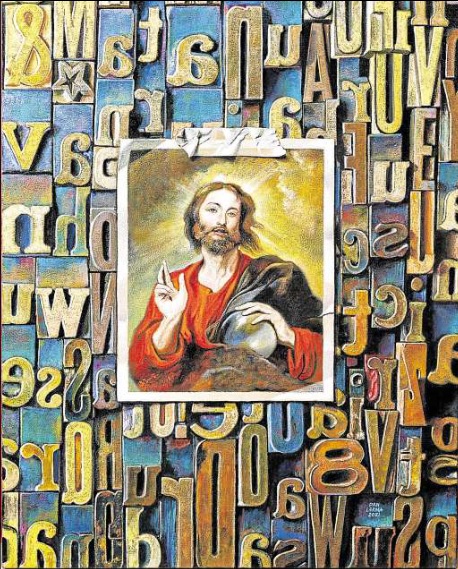A timely if serendipitous exhibit for Lent is “Consummatum Est” at the National Commission for Culture and the Arts (NCCA) Gallery in Intramuros, Manila.
Timely because March 2 marked Ash Wednesday which ushered in Lent.
Serendipitous because the exhibit is really the “Kristo” exhibit of contemporary art depictions of the cross, held annually in different venues before to mark Lent, but which didn’t push through in the last two seasons for obvious reasons. It finally pushed through this new year if only to fill the exhibit program of the NCCA Gallery. It turns out that the “Kristo” organizer and curator Delan Robillos is also a consultant of the NCCA and a curator of its gallery, so “Consummatum Est” was finally fitted into the Intramuros art space’s program this year.
Far often overlooked because the cross has become Christianity’s foremost icon almost to the point of cliché and lachrymose sentimentality, is that, especially for Roman Catholicism, it is also a sacramental invoking God’s protection against diseases and plagues.
Sacramentals
Across the archipelago and across the centuries, pueblos and townships have used plague crosses and saints as sacramentals and prayed for their help to ward off epidemics and other crises.
Pope Francis in the early weeks of the pandemic in 2020 prayed to the Cross of San Marcello al Corso in Rome, a 16th-century plague cross.
Something of the supplicatory value of the plague cross is evoked in Demetrio dela Cruz’s “De-Fence!,” one of the works on exhibit, in which a resin sculpture of three overlapping busts of the Crucified Christ (the troika appears to refer to the triangle of the cross) is crowned by what looks like a miniature welcome arch (a found object, presumably); the icon is set against a field of lavender (Lent) and below it is a fiberglass prayer box which enjoins the devotee to drop her petition.

“Ascending” by Elmer Borlongan is a fascinating mixed-media work presenting the Christ ascending to return to his father in heaven with the iconographic halo consisting of bamboo skewers extending beyond the frame, showering the world with the grace of salvation. The work is both naïf and native, modern and sophisticated.
Supplicatory, propitiatory
Other artworks in “Consummatum Est” somehow evoke the supplicatory, propitiatory aspects of the cross icon, as evident in Robillos’ curator’s notes:
“If Christ uttered the words ‘it is finished’ as His triumph over pain and suffering, can we also say that we have conquered the dreariness that is COVID-19?
“Even with the easing of quarantine and alert levels, the pandemic has already taken its toll on all of us in terms of mental stress and economic distress. The scars of COVID-19 will permanently be there—families and friends claimed by the virus are now just numbers … statistics. After almost two years of sacrifice, the burden is still heavy. Will it really be finished? Will we then ever be saved?”
Mark Arcamo’s “Exalted” is an intriguing urban portrait of Christ, his visage balanced by geometric figures that partly hide, partly reveal him. The amethyst background connotes Lent.
“And the Word was Made Flesh” by Dante Lerma is a trompe l’oeil in which an estampita of Christ is tacked with masking tape on a board of fonts and letters, the physician-artist’s take on the Incarnation.
“Bird’s Nest in the Talahib” is award-winning poet/academician/scholar turned artist Jaime An Lim’s ingenious interpretation of what seems the sepulcher of Christ, which he apparently links with the Lord’s parable of the hidden treasure of God’s redeeming word.
Whimsical
Wilfredo Offemaria Jr.’s “Fishers of Men, Live” is a whimsical updating of Christ’s calling the original apostles to join him, with Simon and the other disciples hauling their net from the Sea of Galilee, and emojis surreally welcoming the sizeable catch.
“Sacrifice,” a conceptual mixed-media work by Jonathan Joven, depicts the cross wrapped in what appears to be personal protective equipment, evoking its power to drive anticipation and reverence despite its ubiquity and predictability.
The brass sculptures in the exhibit complement one another. According to Robillos:
“Michael Cacnio’s work zooms in on two-faced religious hypocrites, those that teach the word of God but fail to enact the teachings themselves. ‘Banal na Aso, Santong Kabayo’ features a praying man with what seems to be, a long devil’s tail. In an August 2021 article on the 1994 song with the same title by Filipino singer, Yano, Fr. Nicanor Lalog … stressed that ‘… even if we have all the soaps and alcohol to wash our hands and all the prayers to recite to stop COVID-19, the virus will persist for as long as we have no regard for the dignity of every person.’
“Juan Sajid Imao’s ‘Trinity,’ on the other hand, shows the crucified Christ supported at the torso by God the Father and the Holy Spirit. The ascending position [alludes] to the resurrecting and ascending Christ similar to his sculpture in the Church of the Gesù in Ateneo de Manila.”
Other participating artists: Emmanuel Nim, Jojo Ballo, Janelle Tang, Anna de Leon, Gem Suguitan, Cathy Lasam, Addie Cukingnan, Bin Samonte, Olie Olivete, Farley del Rosario, Gabi Nazareno, Jill Arwen Posadas and Danny Rayos del Sol. —CONTRIBUTED INQ
Visit storage.net-fs.com/hosting/6438505/1.